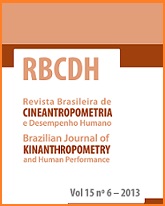Assessment of acute physiological demand for soccer
DOI:
https://doi.org/10.1590/1980-0037.2013v15n6p667Abstract
Soccer is a sport practiced worldwide, on all continents. It is considered an intermittent activity of high intensity and long duration, in which movements that require great strength and speed, such as jumps and sprints, result in high levels of muscle microtrauma, hampering athletes’ training and recovery. The present study aimed to evaluate the magnitude of changes in different markers of physiological demand resulting from a soccer match in healthy individuals. Ten healthy male physical education students participated in the study and were evaluated in two matches: the semi-final and final games of the college tournament at the federal university where they studied. Blood samples were collected from each volunteer pre- and post-match. Cortisol, IL-6 and CK concentrations were increased after the match (p < 0.05). Testosterone and alpha-actin concentrations did not change. Our results indicate that changes in some of the acute response markers evaluated in players before and after competitive soccer matches provide important information for planning training or recovery, as well as nutritional strategies for improving performance.



